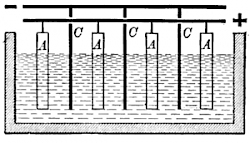Mineral Processing
The kind of processing required to separate valuable minerals and metals from waste rock depends on the type of mineral resource and its properties.
Crushing & Grinding
Crushing and grinding is the process of reducing large chunks of ore to small sand-sized particles. Crushing and grinding are the most expensive steps in mineral processing, but they are necessary in order to liberate and seperate the valuable minerals from the waste rock.

Imagine that a chocolate chip cookie represents a chunk of ore. The chocolate chips represent the valuable mineral we want, and the cookie represents the waste rock.

Looking at the cookie, we can easily pick out the chips we see on the surface, but how do we get to the ones further inside?
 If we break up the cookie, it becomes easier to get at the chocolate chips without taking along any cookie. We can keep breaking the cookie until any single piece is either all chocolate chip, or all cookie. In mining, we would say that we have liberated the chocolate chips.
If we break up the cookie, it becomes easier to get at the chocolate chips without taking along any cookie. We can keep breaking the cookie until any single piece is either all chocolate chip, or all cookie. In mining, we would say that we have liberated the chocolate chips. The same principle applies to recovering grains of minerals from ore. The particle size required to seperate grains of minerals from the waste rock is called liberation size. Ore usually goes through several crushers before being transported to the mill building, where it enters a series of grinding mills that pulverize it into fine sand-sized pieces. Once liberated, there are a number of methods for collecting the minerals, while leaving the waste rock behind.
Caveat: Some methods of mineral extraction, like heap leaching, do not require crushing and grinding.
Froth Flotation & Smelting
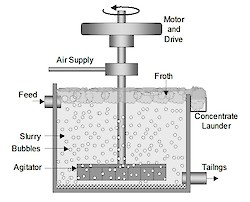 Froth flotation is a method used to recover base metals like copper, zinc and molybdenum, from sulfide ores. The slurry from the grinding mills is mixed with chemical frothers and collectors in large tanks. Air is injected into the bottom of the tank to create bubbles. The bubbles are the key to separating the mineral from waste rock sand (tailings). The mineral sticks to the bubbles and rises to the top of the tank, while the tailings fall to the bottom.
Froth flotation is a method used to recover base metals like copper, zinc and molybdenum, from sulfide ores. The slurry from the grinding mills is mixed with chemical frothers and collectors in large tanks. Air is injected into the bottom of the tank to create bubbles. The bubbles are the key to separating the mineral from waste rock sand (tailings). The mineral sticks to the bubbles and rises to the top of the tank, while the tailings fall to the bottom.The froth is collected and a sent through a series of thickeners to remove the water. The material collected at the end of the froth flotation process is called mineral concentrate.
Smelting is type of metallurgy that is used to produce pure metal from mineral concentrate. This includes production of copper, lead and zinc, as well as precious metals like silver, and iron ore. Smelting involves melting the mineral concentrate in a furnace, along with a mixture of flux and oxygen. Flux refers to a mixture of inert minerals that controls the chemistry of the slag, the unwanted portion of smelted minerals. The portion that contains the desirable metal is called the matte. The matte is seperated from the slag and purified further. The final product of smelting is called blister. Blister copper is about 90% pure copper metal. The blister copper is made into anodes for a final refining process called electrorefining.
Electrorefining is a method similar to electrowinning, that is used to further purify metals from the froth flotation and smelting process. Some products, like electronics, require metals to be very pure to function properly. For example, electric wires must be made from very pure copper to properly conduct electricity. The blister copper produced from smelting is only 90% pure, and contains impurities that reduce its conductivity. In electrorefining, the solution is sulphuric acid, the cathode is made of pure copper or steel, and the anode is made of impure blister copper. During electrolysis, the copper ions from the anode dissolve into the acid and transfer to the cathode. The product is 99.99% pure copper, a quality suitable for further manufacturing.
Heap Leaching & Solvent Extraction Electrowinning (SX-EW)
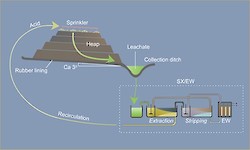 Heap leaching is a method used to recover metals like gold, copper and uranium, from oxide ores. After mining, crushed ore is stacked on a lined pad. A leaching solution is sprayed onto the ore and percolates through to dissolve specific minerals. The mineral-rich leach solution is collected around the base of the pad and piped to a SX-EW plant where pure metal is recovered.
Heap leaching is a method used to recover metals like gold, copper and uranium, from oxide ores. After mining, crushed ore is stacked on a lined pad. A leaching solution is sprayed onto the ore and percolates through to dissolve specific minerals. The mineral-rich leach solution is collected around the base of the pad and piped to a SX-EW plant where pure metal is recovered.Proposed Heap Leach Process video
Solvent extraction electrowinning (SX-EW) is the method of recovering pure metal from the leach solution. In the first step, solvent extraction (SX), the metal in the leach solution is extracted from the mineral using powerful solvents. In the second step, electrowinning (EW), pure metal is recovered from the solvent solution.
Electrowinning is based on the principles of electrolysis. The solvent solution contains positively charged metal ions and negatively charged anions. The purpose of electrowinning is to recover the postively charged metal ions.
To begin the process, two electrodes are inserted into the solvent solution and hooked up to a power source. When the electric current is turned on, the electrodes gain a charge. The positively charged electrode is called the anode, and the negatively charged electrode is called the cathode. The electric current passes through the solution and causes the positively charged metal ions to move towards the cathode and plate onto it. The solution is replenished with positive ions from the anode, and the process continues.
To use copper as an example: the process is complete when there are no copper ions left in the solvent solution; they have all been plated onto the cathode. The cathode copper (99.99% pure) is peeled from the cathode and used to manufacture goods.
Copper Heap Leach & SX-EW Slideshow
In situ leach is a method of mineral extraction similar to heap leaching, that is used to mine underground oxide deposits. The leaching solution is introduced into the deposit through bore holes. It percolates through the ore body and collects in wells constructed around the deposit. The metal-bearing solution is then pumped to the surface, and the metal is recovered by solvent extraction electrowinning (SX-EW).
Gravity Separation
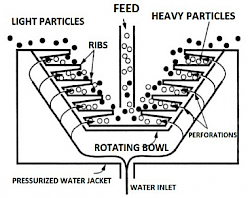
Gravity separation is a method for separating metals or other rock materials of high specific gravity from rocks and minerals of low specific gravity. Gravity separation in moving water is used to concentrate gold, both placer gold and gold recovered from hard rock ore deposits, and for collecting placer platinum.
Knelson, a Langley, BC company, created the first portable devices to concentrate gold by spinning the mineral slurry in a ribbed drum so that lighter waste rock grains spin off the top and and heavy gold grains collect at the bottom.
Gravity separation is also used in coal processing to separate the lighter coal from the sedimentary rock it occurs in.
Magnetic Separation
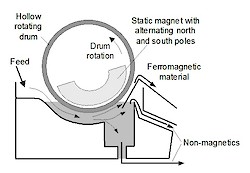 Magnetic separation is a method used to separate and recover magnetic minerals from non-magnetic waste rock or tailings. This method is particularly useful in processing iron deposits in which iron oxide minerals occur with silicate minerals. When pulverized iron ore is conveyed past rotating magnets, the magnetic mineral grains stick to the magnet and are scraped off, while non magnetic waste rock sand (tailings) passes on by,
Magnetic separation is a method used to separate and recover magnetic minerals from non-magnetic waste rock or tailings. This method is particularly useful in processing iron deposits in which iron oxide minerals occur with silicate minerals. When pulverized iron ore is conveyed past rotating magnets, the magnetic mineral grains stick to the magnet and are scraped off, while non magnetic waste rock sand (tailings) passes on by,Magnetic separation is also used in placer gold mining to separate high specific gravity magnetic minerals, like magnetite and pyrite, from gold. It has been used in British Columbia to collect magnetite sand from the tailings of a copper mine to use in coal washing plants.

